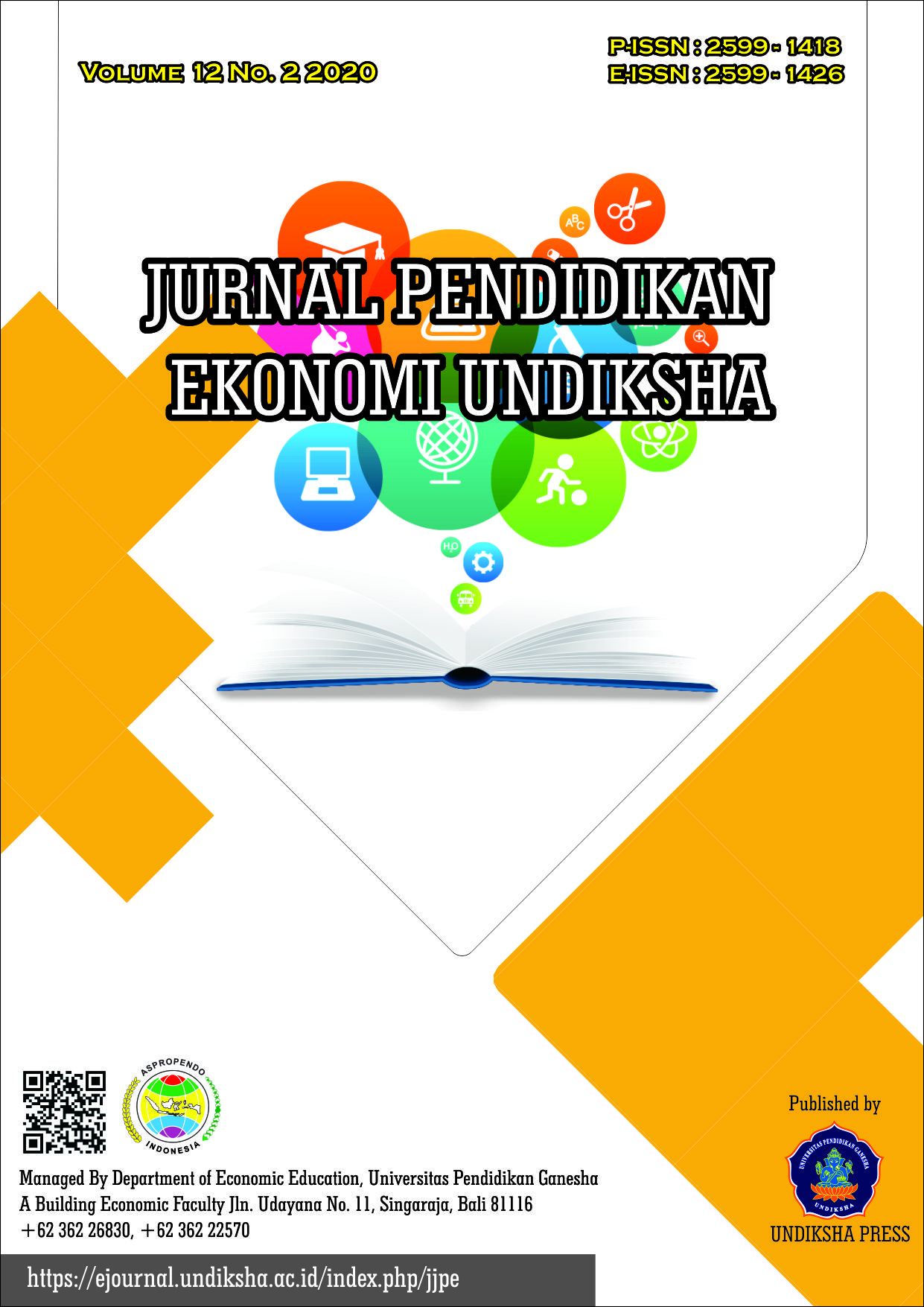Media Pembelajaran Audio Visual Berbasis Aplikasi Canva
DOI:
https://doi.org/10.23887/jjpe.v12i2.30179Kata Kunci:
audio visual, canva application, learning media, online learningAbstrak
This study aims to develop audio visual learning media based on the Canva application. This study uses a Research and Development approach with the stages of initial analysis, material identification, product preparation, and testing. After the product is developed, a feasibility assessment is carried out by the expert to see the feasibility of the media design, match between content, design completeness, and attractiveness. Based on the results of expert judgment, the design of audio visual learning media based on the Canva application obtained a score of 82.28 percent with the very feasible category. The results of limited student responses obtained a score of 86.73 percent with the very feasible category. From the results of expert and student assessments, it means that the Audio-visual learning media based on the Canva application is suitable for use in pilot schools. The results of the first cycle 1 field trials were 67.13 percent and second cycle was 88 percent. The percentage of student learning outcomes shows an increase. This shows that it is easier for students to master labor material using audio-visual learning media based on the Canva application with very good criteria. Thus, the media developed can be used in online and offline learning.
Referensi
Agung, L. (2018). Character Education Integration in Social Studies Learning. Historia: Jurnal Pendidik Dan Peneliti Sejarah, 12(2), 392. https://doi.org/10.17509/historia.v12i2.12111
Ahmad, R. (1997). Media instruksional edukatif. Pt Rineka Cipta.Alazam,
A.-O., Bakar, A. R., Hamzah, R., & Asmiran, S. (2012). Teachers’ ICT Skills and ICT Integration in the Classroom: The Case of Vocational and Technical Teachers in Malaysia. Creative Education, 03(08), 70–76. https://doi.org/10.4236/ce.2012.38b016
Alazam, A.-O., Bakar, A. R., Hamzah, R., & Asmiran, S. (2012). Teachers’ ICT Skills and ICT Integration in the Classroom: The Case of Vocational and Technical Teachers in Malaysia. Creative Education, 03(08), 70–76. https://doi.org/10.4236/ce.2012.38b016
Arini, F. D., Choiri, A. S., & Sunardi. (2017). The Use of Comic As a Learning Aid To Improve Learning Interest of Slow Learner Student. European Journal of Special Education Research, 2(1), 71–78. https://doi.org/10.5281/zenodo.221004
Aslamiyah, L., Masturi, & Nugroho, S. E. (2017). Pengembangan Media Pembelajaran Komik Fisika Berbasis Integrasi-Interkoneksi Nilai-Nilai Alquran. UPEJ Unnes Physics Education Journal, 6(3), 44–52. https://doi.org/10.15294/upej.v6i3.19271
B Boholano, H. (2017). Smart Social Networking: 21st Century Teaching and Learning Skills. Research in Pedagogy, 7(1), 21–29. https://doi.org/10.17810/2015.45
Buchori, A., & Setyawati, R. D. (2015). Development learning model of charactereducation through e-comic in elementary school. International Journal of Education and Research, 3(9), 369–386.
Djamarah, S. B., & Zain, A. (2010). Strategi Belajar Mengajar Jakarta: Rineka Cipta.
Farmawati, E., Ramli, A., & Rahmatullah, R. (2018). Faktor-Faktor Yang Mempengaruhi Kinerja Guru Ekonomi Pada SMA Negeri Di Kota Makassar. JEKPEND: Jurnal Ekonomi Dan Pendidikan, 1(2), 23–29.
Gafur, A. (2012). Desain pembelajaran: Konsep, model, dan aplikasinya dalam perencanaan pelaksanaan pembelajaran. Yogyakarta: Ombak.
Inanna, I., Rahmatullah, R., Haeruddin, M. I. M., & Marhawati, M. (2020). Silk Weaving As A Cultural Heritage In The Informal Silk Weaving As A Cultural Heritage In The Informal Entrepreneurship Education Perspective. Journal of Entrepreneurship Education, 23(1), 1–11.
Isman, A. (2011). Instructional Design In Education: New Model. TOJET: The Turkish Online Journal of Educational Technology, 10(1), 136–142.
Mahnun, N. (2012). Media pembelajaran (kajian terhadap langkah-langkah pemilihan media dan implementasinya dalam pembelajaran). An-Nida’, 37(1), 27–34.
Muhson, A. (2010). Pengembangan media pembelajaran berbasis teknologi informasi. Jurnal Pendidikan Akuntansi Indonesia, 8(2).
Nasrullah, M., Ilmawati, I., Saleh, S., Niswaty, R., & Salam, R. (2018). Minat Menjadi Guru Pada Mahasiswa Program Studi Pendidikan Administrasi Perkantoran Fakultas Ilmu Sosial Universitas Negeri Makassar. Jurnal Ad’ministrare, 5(1), 1–6.
Negrete, A. (2013). Constructing a Comic to Communicate Scientific Information about Sustainable Development and Natural Resources in Mexico. Procedia - Social and Behavioral Sciences, 103(November 2013), 200–209. https://doi.org/10.1016/j.sbspro.2013.10.327
Ntobuo, N. E., Arbie, A., & Amali, L. N. (2018). The development of gravity comic learning media based on gorontalo culture. Jurnal Pendidikan IPA Indonesia, 7(2), 246–251. https://doi.org/10.15294/jpii.v7i2.14344
Rahmatullah, R., & Inanna, I. (2017). Identifikasi Nilai-Nilai Ekonomi Sebagai Dasar Merumuskan Materi Pengantar Ilmu Ekonomi Berjatidiri Bangsa. Prosiding Seminar Nasional, 700–704. Retrieved from http://eprints.unm.ac.id/11439/1/PROSIDING NASIONAL MEMBANGUN INDONESIA.pdf
Rahmatullah, R., Inanna, I., & Nurdiana, N. (2019). Ethnopedagogi dalam pembelajaran ekonomi. Seminar Nasional Lembaga Penelitian UNM, 284–288.
Rahmatullah, & Inanna. (2019). Pelatihan Penulisan Penelitian Tindakan Kelas Bagi Guru. Jurnal Dedikasi Masyarakat, 3(1), 19–25
Ramli, A., Rahmatullah, Inanna, & Dangnga, T. (2018). Peran Media Dalam Meningkatkan Efektivitas Belajar. Lembaga Pengabdian Kepada Masyarakat Universitas Negeri Makassar, 5–7. https://ojs.unm.ac.id/semnaslpm/article/download/7649/4429%0A
Reiser, R. A. (2001). A history of instructional design and technology: Part II: A history of instructional design. Educational Technology Research and Development, 49(2), 57–67. https://doi.org/10.1007/BF02504928
Reiser, R. A., & Dick, W. (1996). Instructional planning: A guide for teachers. Allyn and Bacon.
Rokhayani, A., Ririn, A., & Utari, P. (2014). the Use of Comic Strips As an English Teaching Media for Junior High School Students. Language Circle - Journal of Language and Literature, 8(2), 143–149. https://doi.org/10.15294/lc.v8i2.3018
Rosmawati, H. (2018). Penerapan Model Pembelajaran Kooperatif Tipe Snowball Throwing Untuk Meningkatkan Hasil Belajar EKONOMI Siswa Kelas VIII. B SMP Negeri 33 Makassar. JEKPEND: Jurnal Ekonomi Dan Pendidikan, 1(1), 34–44.
Said, A. A. (2016). Desain Multimedia Pembelajaran. Seminar Nasional “Revitalisasi Pendidikan Seni Dan Desain Sebagai Basis Pengembangan SDM,” 1, 239.
Sharif, A., & Gisbert, M. (2015). The Impact of Culture on Instructional Design and Quality Afsaneh. International Journal of Instruction, 8(1), 143–156.
Sutarno, E., & Mukhidin. (2013). Pengembangan Model Pembelajaran Berbasis Multimedia Interaktif Pengukuran Untuk Meningkatkan Hasil Dan Kemandirian Belajar Siswa Smp Di Kota Bandung. Jurnal Pendidikan Teknologi Dan Kejuruan, 21(3), 203–218. https://doi.org/10.21831/jptk.v21i3.3258
Tsai, K. C. (2012). Bring character education into classroom. European Journal of Educational Research, 1(2), 163–170. https://doi.org/10.12973/eu-jer.1.2.163
West, R. E., Thomas, R. A., Bodily, R., Wright, C., & Borup, J. (2016). An analysis of instructional design and technology departments. Educational Technology Research and Development, 65(4), 869–888. https://doi.org/10.1007/s11423-016-9490-1
Yulianti, Y. (2019). Contextual Teaching Learning Dalam Pembelajaran Ekonomi. Pinisi Business Administration Review, 1(2).





